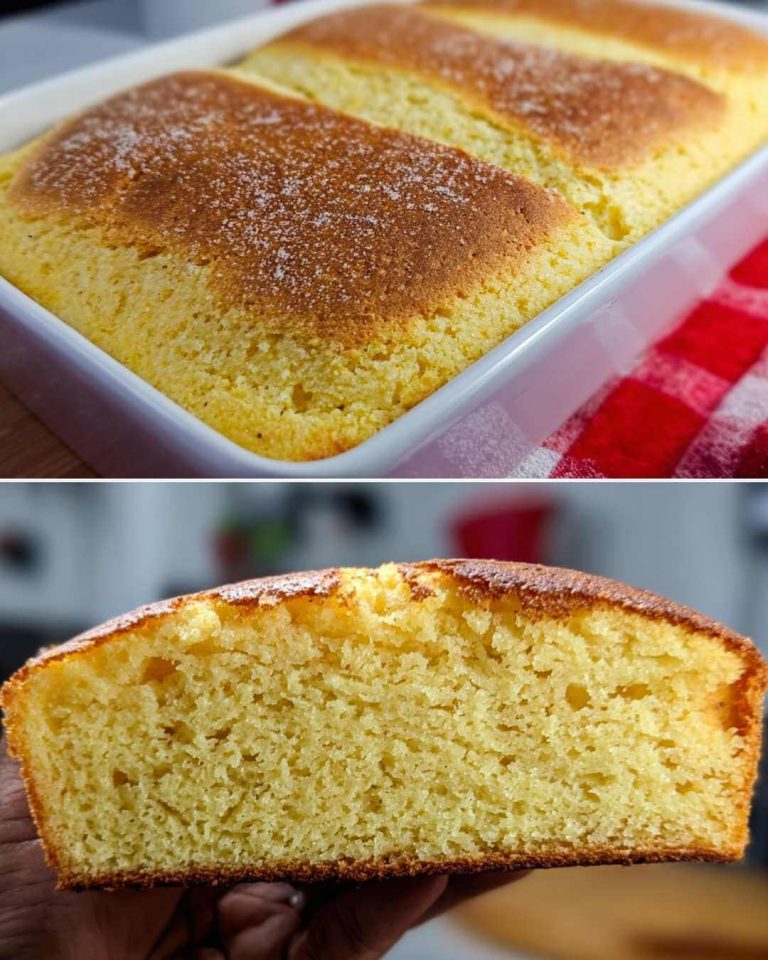This traditional Brazilian corn bread combines the sweet flavor of corn with a soft, fluffy texture that’s far superior to store-bought bread. Made with real corn kernels and corn flakes, it’s packed with fiber and natural nutrients while being completely free of preservatives.
Ingredients
For the Bread:
- 300ml warm water (10 fl oz / 1¼ cups)
- 1 can corn kernels, drained (200g / 7 oz)
- ½ cup corn flakes (30g / 1 oz)
- 2 large eggs (room temperature)
- 100ml vegetable oil (3.4 fl oz / ⅓ cup + 1 tbsp)
- 3 tablespoons granulated sugar (45g / 1.6 oz)
- 1 level tablespoon salt (15g)
- 15g active dry yeast (1 tbsp + ½ tsp)
- 2 tablespoons margarine or butter (30g / 1 oz)
- 700g all-purpose flour (24.7 oz / 5½ cups)
For Finishing:
- 1 egg for brushing
- 2 tablespoons corn flakes, finely ground
Instructions
Step 1: Prepare the Corn Mixture
In a blender, combine the warm water and drained corn kernels. Blend for 2 minutes until well processed but not completely smooth – you want some texture remaining for fiber. Pour the mixture into a large bowl and add the corn flakes. Stir well and let sit for 10 minutes to allow the corn flakes to soften and absorb moisture.
Step 2: Add Wet Ingredients
In a separate bowl, beat the eggs lightly. Add the vegetable oil, sugar, salt, yeast, and margarine to the corn mixture. Mix in the beaten eggs and stir thoroughly until all ingredients are well combined and the yeast is completely dissolved.
Step 3: Form the Dough
Gradually add the flour, mixing continuously. Start with about 500g of flour, then add the remaining flour slowly until you achieve a soft, slightly sticky dough that doesn’t stick heavily to your hands. The dough should be softer than typical bread dough to ensure a fluffy texture.
Step 4: Knead the Dough
Turn the dough onto a lightly floured surface and knead gently for about 5 minutes. The kneading should be light – just enough to create a smooth, elastic texture. Don’t overwork the dough.
Step 5: First Rise
Divide the dough into 3 equal portions. Place each portion in a lightly floured bowl, cover with a clean kitchen towel, and let rise for 20-30 minutes until doubled in size.
Step 6: Shape and Second Rise
Grease a large baking pan with oil and dust with flour. Shape each portion into a loaf and place in the prepared pan, leaving space between each loaf. Cover again and let rise for another 10-15 minutes until puffy.
Step 7: Prepare for Baking
Beat the egg for brushing. Gently brush the tops of the loaves with beaten egg. Sprinkle the finely ground corn flakes over the tops for a traditional finish.
Step 8: Bake
Preheat oven to 150-160°C (300-320°F). Bake for 25 minutes, or until the bread is golden brown and sounds hollow when tapped. If desired, turn on the broiler for the last 3-4 minutes to achieve a deeper golden color.
Step 9: Cool and Serve
Let the bread cool in the pan for 10 minutes before removing. The bread should release easily due to the greasing and flouring.
Time and Serving Information
Prep Time: 20 minutes
Rising Time: 40 minutes total
Baking Time: 25 minutes
Total Time: 1 hour 25 minutes
Servings: 3 small loaves (24 slices total)
Nutrition (Per Slice)
- Calories: 145
- Carbs: 28g
- Protein: 4g
- Fat: 3g
- Fiber: 2g
- Iron: 8% DV
Why This Corn Bread is Nutritionally Superior
This homemade corn bread offers significant nutritional advantages over commercial bread. The whole corn kernels provide natural fiber, B-vitamins, and antioxidants like lutein and zeaxanthin, which support eye health. By keeping the corn skins in the mixture rather than straining them out, you retain valuable dietary fiber that aids digestion and helps maintain stable blood sugar levels.
The bread is naturally free from artificial preservatives, high fructose corn syrup, and unnecessary additives commonly found in store-bought bread. The combination of corn and wheat provides a complete amino acid profile, making it more nutritionally balanced than plain white bread. The moderate amount of oil and eggs adds healthy fats and protein, while the natural corn sugars provide sustained energy without the blood sugar spikes associated with highly processed breads.
